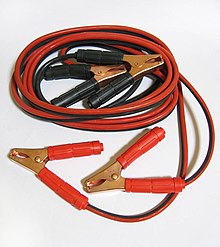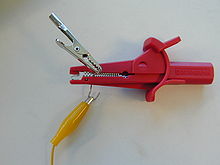This article needs additional citations for verification. (May 2013) |




A crocodile clip or alligator clip[1] is a plier-like spring-tensioned metal clip with elongated, serrated jaws that is used for creating a temporary electrical connection. This simple mechanical device gets its name from the resemblance of its serrated jaws to the toothed jaws of a crocodile or alligator. It is used to clamp and grab onto a bare electrical cable to a lead on a battery or some other electrical component. The clip's tapered, serrated jaws are forced together by a spring to grip an object. A Clothespin or Kelvin clip is a special form of crocodile clip whose jaws are insulated from each other, allowing two isolated wires to connect to a single test point. This enables 4-wire measurement of circuits with very low resistances. When manufactured for electronics testing and evaluation, one jaw of the clip is typically permanently crimped or soldered to a wire, or is bent to form the inner tubular contact of a ~4 mm (0.16 in) female banana jack, enabling quick non-permanent connection between a circuit under test and laboratory equipment or to another electrical circuit. The clip is typically covered by a plastic shroud or "boot" to prevent accidental short-circuits.
Small versions, ranging in size from 15–40 mm (0.59–1.57 in) in length, are used in electrical laboratory work.
Large versions of these clips, called automotive clips or battery clamps, are made of solid copper for low electrical resistance, and are used with thick insulated copper cables to make connections between automobile batteries. These jumper cables (a.k.a. 'jump leads') are capable of delivering hundreds of Amperes of current needed to directly power an automobile starter motor, or to transfer energy from a charged lead–acid battery to a discharged one.
- ^ "Guide to Clips". Mueller Electric. February 19, 2018. Archived from the original on February 15, 2022. Retrieved February 19, 2018.